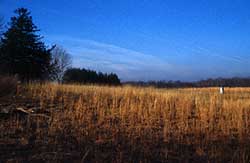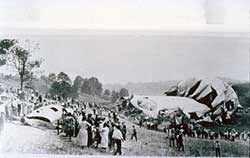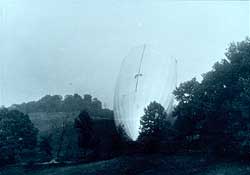
The USS Shenandoah, the first rigid airship built in the United States and the first in the world to be inflated with helium, was a pioneer in the history of American airship aviation. It's loss in a crash in Noble County, Ohio had important consequences for the future of the American military and its airship program. Commanded and staffed by personnel from the U.S. Navy, it was intended for use as a scouting vessel, based on German Zeppelins used during World War I. In 1917 the Navy purchased its first airship, a non-rigid or blimp (one that consists of a single gas container similar to modern blimps). The Navy soon began to plan construction of several of its own rigid airships. These rigid airships possessed a rigid framework or hull that contained several multiple gasbags. The plans called for the use of helium in the gas bags, instead of highly flammable hydrogen, as the U.S. had the world's only known large deposits of helium in the petroleum fields at Fort Worth, Texas. Construction of the ZR-1 airship, which became the Shenandoah, was authorized in August 1919, but delays involved in the construction of Hangar No. 1 at the Naval Air Station at Lakehurst, New Jersey, needed to house it, kept it from being completed until the summer of 1923. The design was based on a German Zeppelin downed on a bombing raid over France in 1917, although modifications were made on the volume, the bow and controls. A new alloy called duralumin, consisting of aluminum, copper and several other metals, was developed for use in the Shenandoah frame. This alloy had the strength of steel but the lightness of aluminum. The Shenandoah was 680 feet long, its maximum diameter was 78.7 feet and maximum height 93 feet. Its five 300-horse power, six-cylinder Packard engines reached a top speed of 60 mph and could carry a useful load of 33 tons.

On September 4, 1923, the Shenandoah successfully completed its maiden voyage. The airship took part in a series of mooring exercises at Lakehurst and to a short mast on the fleet tender the USS Patoka, the only airship tender in naval history. Lieutenant Commander Zachary Lansdowne assumed command of the Shenandoah on February 16, 1924. The Shenandoah's most impressive flight occurred in October 1924 when it made a transcontinental flight from Lakehurst to the West Coast and back. The publicity from this trip, heralded as a forerunner of commercial airship service, caused the Navy to plan a Midwestern tour in the summer of 1925 for 40 city "fly-overs" and state fair visits. As a native of Ohio, Lansdowne realized that at that time of the year the Great Lakes region was subject to violent and dangerous storms.

On the afternoon of September 2, 1925, the Shenandoah departed from its Lakehurst hangar with a crew of 41 and two passengers. Traveling west across the Alleghenies into Ohio, the airship confronted a severe storm by the early morning near Ava in northern Noble County. Initially, the ship changed course slightly to fly around the storm; however, aware of the Navy's tight schedule and fearful of losing too much time, Lansdowne decided against flying south to clearer skies. At about 6:00 am on the morning of September 3, the Shenandoah was suddenly caught in a violent updraft of warm air, rising at the rate of a meter a second. At about 6,200 feet the ascent was checked, but the ship began to fall at a faster rate. When halfway to the ground it was hit by another warm air current and began to rise rapidly once more, but then descended again. On the third ascent the ship was hit by a turbulent side wind, twisting the hull and breaking it. The control car with Lansdowne and six other crewmen broke loose from its position below the bow and dropped to earth near the Andrew Gamary tenant farmhouse, killing all occupants. Seconds later six more crewmen, who were either in the hull at the point of break-up or in the gondolas toward the stern, plunged to their deaths in the fields below. The stern section, over 400 feet long, glided to earth with 18 men aboard and hit the ground near the Gamary farm with the tail in the air, where it dragged along the ground near a treeline until it was momentarily snagged and four men were dumped out. The air then picked it up and lodged the stern against an opposite hillside.

The 200-foot bow section, with seven crewmen, quickly rose to 10,000 feet, but was brought under control by venting helium from the intact gas bags and releasing gasoline from the fuel tanks. Fifty-three minutes later it floated down about six miles to the south of the initial break-up. As it approached the ground it brushed the Ernest Nichols farmhouse west of the crossroads of Sharon, tore out a post and a pole and scraped over the garage roof. Nichols grabbed a line thrown from the bow and secured it to a pair of trees. Finally grounded, the crew jumped out, borrowed a shotgun from Nichols and burst the gasbags before the bow was blown any further. The Lieutenant Commander who had guided the bow to earth, Captain Rosendahl, used the Nichols's telephone to call the telegraph office at Caldwell and inform naval officers of the disaster. Twenty-nine members of the crew survived the break-up, although some received serious injuries.
Although the FBI attempted to guard the crash-site along with 40 Ohio National Guardsmen, wholesale looting of the site had already been accomplished. A court of inquiry was convened at the Gamary farm under Army Major C.W. Cook stationed at Fort Hayes in Columbus, and later naval officers in Washington, D.C., convened a formal court. Study of the disaster led to the conclusion that much stronger construction of future airship hulls was necessary. An improved "fineness ratio" or diameter to length ratio, was required, and control cars in the future were built into the keel instead of being suspended from struts as in the Shenandoah. Engine power was upgraded to allow airships to outmaneuver storms and an improved weather forecasting service was developed for the armed services.
Visit the National Park Service Travel American Aviation to learn more about Aviation related Historic Sites.
Last updated: September 3, 2017
